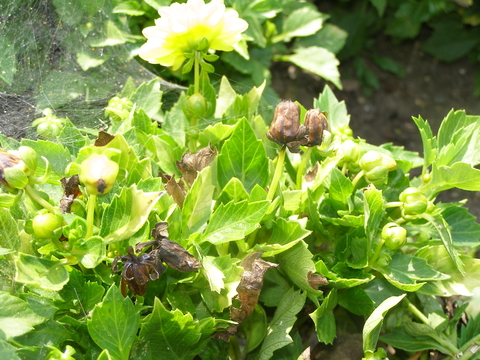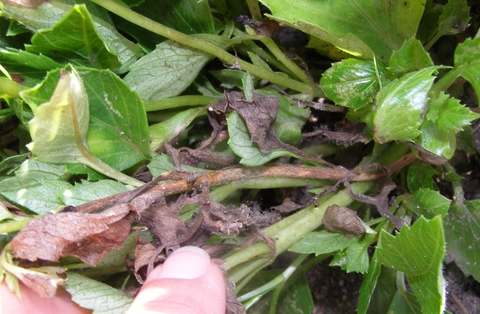Quick facts
- Gray mold is a fungal disease that blights flowers, leaves and stems of many different flowering plants.
- Wounded and old plant tissue and flowers are easily infected by gray mold.
- Gray mold is common in wet or very humid conditions.
- The best way to prevent gray mold is to space out plants so they have room to dry out after rain or watering.
- Remove infected flowers, leaves and stems. Infected plant parts should be buried or composted.
- Many flowering plants can recover from gray mold when warm, dry conditions return.
How to identify gray mold
- Gray mold causes a dark brown to black blight of flowers, buds, leaves and stems.
- Infected flowers and flower buds turn completely brown or black.
- On plants with large petals, brown spots may form on petals.
- Leaf spots often form near a wound or where an infected petal has fallen onto the leaf.
- Leaf spots are large round brown blotches with target like rings of darker brown.
- In wet weather, leaf spots can grow to turn the entire leaf brown.
- Flower and leaf infections can progress into stems. Infected stems are brown and may have target like darker brown rings.
How gray mold survives and spreads
- Gray mold is caused by the fungus Botrytis cinerea.
- The gray mold fungus is able to infect a large number of plants including many common flowering plants, fruits, and vegetables.
- It can also live on dead leaves and other plant debris.
- As a result the gray mold fungus can be found in most gardens in Minnesota.
- Infection often starts on wounded or old plant tissue. Flowers are also easily infected by the gray mold fungus.
- Powdery spores are produced on all infected plant parts. These spores spread by wind or splashing water to new plants.
- The gray mold fungus thrives in wet weather or high humidity.
How to manage gray mold
Provide good air circulation
- Gray mold can show up anytime wet weather occurs during the growing season.
- Space your plants properly to encourage good air circulation between plants.
- Split or thin overgrown perennials.
- Keep your plants dry.
- Avoid overhead watering.
- Use drip irrigation or a soaker hose.
- Don't water late in the day. Give your plants time to dry off after watering them.
Take care not to wound plants
- Infections usually begin on weak, dying or wounded plant tissue.
- Handle plants carefully when transplanting and pruning.
- Gray mold usually attacks wounded plants, so avoid harming your plants.
- Prune plants later in the day when plants they are dry.
Keep your garden clean
- Remove infected plants or plant parts in a paper bag. Bury or compost all infected plant parts.
- Compost stems, leaves, and flowers that are removed for deadheading and other garden maintenance.
- Many moths, butterflies, bumble bees and other wildlife rely on leaf litter and plant debris for winter protection.
- Allow fallen leaves and other plant debris from healthy plants to remain in the garden over winter.
- Remove and compost leaves, stems, flowers and plants that have been infected with gray mold or other fungal diseases.
Fungicides
- Fungicides are not necessary to control gray mold in the flower garden.
- Cultural control practices will reduce gray mold to an acceptable level.
- Many flowering plants will recover from gray mold once dry conditions return.
Reviewed in 2024



